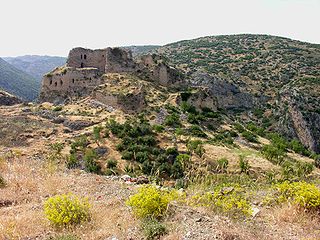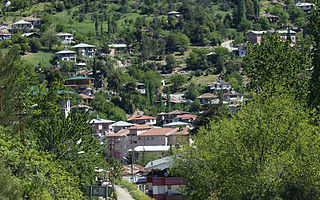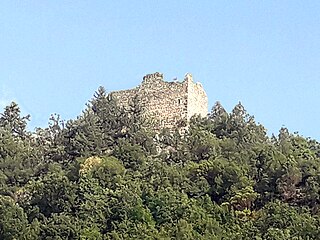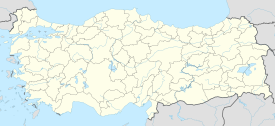
Cilicia is a geographical region in southern Anatolia in Turkey, extending inland from the northeastern coasts of the Mediterranean Sea. Cilicia has a population ranging over six million, concentrated mostly at the Cilicia plain. The region includes the provinces of Mersin, Adana, Osmaniye, along with parts of Hatay and Antalya.

The Cilician Gates or Gülek Pass is a pass through the Taurus Mountains connecting the low plains of Cilicia to the Anatolian Plateau, by way of the narrow gorge of the Gökoluk River. Its highest elevation is about 1000m.

Corycus was an ancient city in Cilicia Trachaea, Anatolia, located at the mouth of the valley called Şeytan deresi; the site is now occupied by the town of Kızkalesi, Mersin Province, Turkey.
Lampron is a castle near the town of Çamlıyayla in Mersin Province, Turkey. While part of the Armenian Kingdom of Cilicia in the Middle Ages, the castle was known as Lampron and was the ancestral home of the Armenian Hethumid princes. Situated in the Taurus Mountains, the fortress guarded passes to Tarsus and the Cilician Gates.

Silifke is a town and district in south-central Mersin Province, Turkey, 80 km (50 mi) west of the city of Mersin, on the west end of Çukurova.

Mersin Province, formerly İçel Province, is a province in southern Turkey, on the Mediterranean coast between Antalya and Adana. The provincial capital and the biggest city in the province is Mersin, which is composed of four municipalities and district governorates: Akdeniz, Mezitli, Toroslar and Yenişehir. Next largest is Tarsus, the birthplace of Paul the Apostle. The province is considered to be a part of the geographical, economical and cultural region of Çukurova, which covers the provinces of Mersin, Adana, Osmaniye and Hatay.

Bagras or Baghrās, ancient Pagrae, is a town and its nearby castle in the İskenderun district of Turkey, in the Amanus Mountains.

Feke is a small city and a district in Adana Province of Turkey, 122 km from the city of Adana, 620m above sea-level, a small town on attractive forested mountainside. The current mayor is Ahmet Sel (MHP).
Constantine of Baberon was a powerful Armenian noble of the Het‛umid family. He was the son of Vassag and the father of King Het‛um I, who ruled the Armenian Kingdom of Cilicia from 1226 to 1270. Constantine played a pivotal role in placing his son on the throne by engineering the murder of Philip, the husband of Isabella, Queen of Armenia. He tricked Philip's father, Bohemond IV of Antioch, to search for his son at Amouda rather than at Sis, where he was being tortured and poisoned. He then took his army to the gates of Silifke Castle, forced its Frankish lords to surrender Isabella, and arranged the marriage, making his son the first Het‛umid ruler of the Armenian Kingdom.
Gülek is a town in Mersin Province, Turkey.

Limonlu is a small town in Mersin Province, Turkey.

Sis was the capital of the Armenian Kingdom of Cilicia. The massive fortified complex is just to the southwest of the modern Turkish town of Kozan in Adana Province.

Çandır Castle the medieval Armenian site of Paperon, is a fortification in Mersin Province, Turkey.

Kızkalesi is an island castle situated on a small island in Mersin Province of Turkey.

Karakabaklı is an archaeological site in Mersin Province, Turkey.

Kilise Tepe is a mound in Mersin Province, Turkey, just west of the Göksu River, lying 20 kilometers from Mut and 145 kilometers from Mersin. It was initially known as Maltepe which is actually the name of a site on the other bank of the river about four kilometers to the west. The original name of the mound is not known and Kilise Tepe in Turkish means "church-hill" referring to a church ruin. The site is thought to have been part of the land of Tarḫuntašša, formed when Muwatalli II moved the Hittite capital.

Tece Castle is a ruined castle in Mersin Province, southern Turkey.

Kuzucubelen Castle is a castle ruin in Mersin Province, Turkey.

Gülek Castle is a medieval castle in Mersin Province, Turkey.

Evciler Castle, also called as Kızılbağ Castle, and Evcili Castle is a small medieval castle in Mersin Province, Turkey.





















